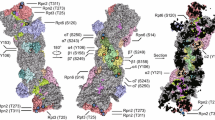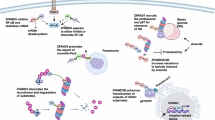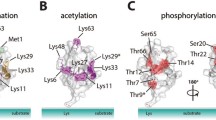Abstract
Rates of degradation by the ubiquitin proteasome system depend not only on rates of ubiquitination, but also on the level of proteasome activity which can be regulated through phosphorylation of proteasome subunits. Many protein kinases have been proposed to influence proteasomal activity. However, for only two is there strong evidence that phosphorylation of a specific 26S subunit enhances the proteasome’s capacity to degrade ubiquitinated proteins and promotes protein breakdown in cells: (1) protein kinase A (PKA), which after a rise in cAMP phosphorylates the 19S subunit Rpn6, and (2) dual tyrosine receptor kinase 2 (DYRK2), which during S through M phases of the cell cycle phosphorylates the 19S ATPase subunit Rpt3. In this chapter, we review and discuss the different methods used to assess the impact of phosphorylation by these two kinases on proteasomal activity and intracellular protein degradation. In addition, we present one method to determine if phosphorylation is responsible for an observed increase in proteasomal activity and another to evaluate by Phos-tag gel electrophoresis whether a specific proteasome subunit is modified by phosphorylation. The methods reviewed and presented here should be useful in clarifying the roles of other kinases and other posttranslational modifications of proteasome subunits.
Access this chapter
Tax calculation will be finalised at checkout
Purchases are for personal use only
Similar content being viewed by others
References
VerPlank JJS, Goldberg AL (2017) Regulating protein breakdown through proteasome phosphorylation. Biochem J 474(19):3355–3371. https://doi.org/10.1042/bcj20160809
Guo X, Huang X, Chen MJ (2017) Reversible phosphorylation of the 26S proteasome. Protein Cell 8(4):255–272. https://doi.org/10.1007/s13238-017-0382-x
Lokireddy S, Kukushkin NV, Goldberg AL (2015) cAMP-induced phosphorylation of 26S proteasomes on Rpn6/PSMD11 enhances their activity and the degradation of misfolded proteins. Proc Natl Acad Sci U S A 112(52):E7176–E7185. https://doi.org/10.1073/pnas.1522332112
Guo X, Wang X, Wang Z, Banerjee S, Yang J, Huang L, Dixon JE (2016) Site-specific proteasome phosphorylation controls cell proliferation and tumorigenesis. Nat Cell Biol 18(2):202–212. https://doi.org/10.1038/ncb3289
Ranek MJ, Terpstra EJ, Li J, Kass DA, Wang X (2013) Protein kinase g positively regulates proteasome-mediated degradation of misfolded proteins. Circulation 128(4):365–376. https://doi.org/10.1161/circulationaha.113.001971
Ranek MJ, Kost CK Jr, Hu C, Martin DS, Wang X (2014) Muscarinic 2 receptors modulate cardiac proteasome function in a protein kinase G-dependent manner. J Mol Cell Cardiol 69:43–51. https://doi.org/10.1016/j.yjmcc.2014.01.017
Djakovic SN, Schwarz LA, Barylko B, DeMartino GN, Patrick GN (2009) Regulation of the proteasome by neuronal activity and calcium/calmodulin-dependent protein kinase II. J Biol Chem 284(39):26655–26665
Um JW, Im E, Park J, Oh Y, Min B, Lee HJ, Yoon JB, Chung KC (2010) ASK1 negatively regulates the 26 S proteasome. J Biol Chem 285(47):36434–36446. https://doi.org/10.1074/jbc.M110.133777
Asai M, Tsukamoto O, Minamino T, Asanuma H, Fujita M, Asano Y, Takahama H, Sasaki H, Higo S, Asakura M, Takashima S, Hori M, Kitakaze M (2009) PKA rapidly enhances proteasome assembly and activity in in vivo canine hearts. J Mol Cell Cardiol 46(4):452–462. https://doi.org/10.1016/j.yjmcc.2008.11.001
Zhang F, Hu Y, Huang P, Toleman CA, Paterson AJ, Kudlow JE (2007) Proteasome function is regulated by cyclic AMP-dependent protein kinase through phosphorylation of Rpt6. J Biol Chem 282(31):22460–22471. https://doi.org/10.1074/jbc.M702439200
Myeku N, Clelland CL, Emrani S, Kukushkin NV, Yu WH, Goldberg AL, Duff KE (2016) Tau-driven 26S proteasome impairment and cognitive dysfunction can be prevented early in disease by activating cAMP-PKA signaling. Nat Med 22(1):46–53. https://doi.org/10.1038/nm.4011
Lokireddy S, VerPlank JJS, Zhao J, Davogusotto G, Parker B, James D, Richter E, Taegetmeyer H, Goldberg AL. Hormones, exercise, and fasting activate 26S proteasome function via cAMP-PKA pathway. Manuscript in revision
Besche HC, Goldberg AL (2012) Affinity purification of mammalian 26S proteasomes using an ubiquitin-like domain. Methods Mol Biol 832:423–432. https://doi.org/10.1007/978-1-61779-474-2_29
VerPlank JJS, Lokireddy S, Feltri ML, Goldberg AL, Wrabetz L (2018) Impairment of protein degradation and proteasome function in hereditary neuropathies. Glia 66(2):379–395. https://doi.org/10.1002/glia.23251
Kinoshita E, Kinoshita-Kikuta E, Koike T (2009) Separation and detection of large phosphoproteins using Phos-tag SDS-PAGE. Nat Protoc 4(10):1513–1521. https://doi.org/10.1038/nprot.2009.154
Lee SH, Park Y, Yoon SK, Yoon JB (2010) Osmotic stress inhibits proteasome by p38 MAPK-dependent phosphorylation. J Biol Chem 285(53):41280–41289. https://doi.org/10.1074/jbc.M110.182188
Leestemaker Y, de Jong A, Witting KF, Penning R, Schuurman K, Rodenko B, Zaal EA, van de Kooij B, Laufer S, Heck AJR, Borst J, Scheper W, Berkers CR, Ovaa H (2017) Proteasome activation by small molecules. Cell Chem Biol 24(6):725–736.e7. https://doi.org/10.1016/j.chembiol.2017.05.010
Collins GA, Goldberg AL (2017) The logic of the 26S proteasome. Cell 169(5):792–806. https://doi.org/10.1016/j.cell.2017.04.023
Zhao J, Zhai B, Gygi SP, Goldberg AL (2015) mTOR inhibition activates overall protein degradation by the ubiquitin proteasome system as well as by autophagy. Proc Natl Acad Sci U S A 112(52):15790–15797. https://doi.org/10.1073/pnas.1521919112
Zhao J, Brault JJ, Schild A, Cao P, Sandri M, Schiaffino S, Lecker SH, Goldberg AL (2007) FoxO3 coordinately activates protein degradation by the autophagic/lysosomal and proteasomal pathways in atrophying muscle cells. Cell Metab 6(6):472–483. https://doi.org/10.1016/j.cmet.2007.11.004
Filipcik P, Curry JR, Mace PD (2017) When worlds collide-mechanisms at the Interface between phosphorylation and ubiquitination. J Mol Biol 429(8):1097–1113. https://doi.org/10.1016/j.jmb.2017.02.011
Zhang F, Su K, Yang X, Bowe DB, Paterson AJ, Kudlow JE (2003) O-GlcNAc modification is an endogenous inhibitor of the proteasome. Cell 115(6):715–725
Cho-Park PF, Steller H (2013) Proteasome regulation by ADP-ribosylation. Cell 153(3):614–627. https://doi.org/10.1016/j.cell.2013.03.040
Besche HC, Sha Z, Kukushkin NV, Peth A, Hock EM, Kim W, Gygi S, Gutierrez JA, Liao H, Dick L, Goldberg AL (2014) Autoubiquitination of the 26S proteasome on Rpn13 regulates breakdown of ubiquitin conjugates. EMBO J 33(10):1159–1176. https://doi.org/10.1002/embj.201386906
Marshall RS, McLoughlin F, Vierstra RD (2016) Autophagic turnover of inactive 26S proteasomes in yeast is directed by the ubiquitin receptor Cue5 and the Hsp42 chaperone. Cell Rep 16(6):1717–1732. https://doi.org/10.1016/j.celrep.2016.07.015
Acknowledgments
The methods described here were developed through research support to our laboratory from the NIH-NIGMS (R01 GM51923), Cure Alzheimer’s Fund, Muscular Dystrophy Association (MDA-419143), and Project A.L.S (2015-06).
Author information
Authors and Affiliations
Corresponding author
Editor information
Editors and Affiliations
Rights and permissions
Copyright information
© 2018 Springer Science+Business Media, LLC, part of Springer Nature
About this protocol
Cite this protocol
VerPlank, J.J.S., Goldberg, A.L. (2018). Exploring the Regulation of Proteasome Function by Subunit Phosphorylation. In: Mayor, T., Kleiger, G. (eds) The Ubiquitin Proteasome System. Methods in Molecular Biology, vol 1844. Humana Press, New York, NY. https://doi.org/10.1007/978-1-4939-8706-1_20
Download citation
DOI: https://doi.org/10.1007/978-1-4939-8706-1_20
Published:
Publisher Name: Humana Press, New York, NY
Print ISBN: 978-1-4939-8705-4
Online ISBN: 978-1-4939-8706-1
eBook Packages: Springer Protocols




